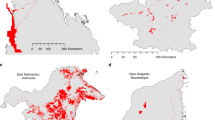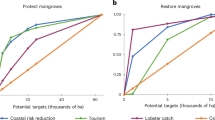Abstract
Efforts to avert dangerous climate change by conserving and restoring natural habitats are hampered by concerns over the credibility of methods used to quantify their long-term impacts. Here we develop a flexible framework for estimating the net social benefit of impermanent nature-based interventions that integrates three substantial advances: (1) conceptualizing the permanence of a project’s impact as its additionality over time; (2) risk-averse estimation of the social cost of future reversals of carbon gains; and (3) post-credit monitoring to correct errors in deliberately pessimistic release forecasts. Our framework generates incentives for safeguarding already credited carbon while enabling would-be investors to make like-for-like comparisons of diverse carbon projects. Preliminary analyses suggest nature-derived credits may be competitively priced even after adjusting for impermanence.
This is a preview of subscription content, access via your institution
Access options
Access Nature and 54 other Nature Portfolio journals
Get Nature+, our best-value online-access subscription
$29.99 / 30 days
cancel any time
Subscribe to this journal
Receive 12 print issues and online access
$209.00 per year
only $17.42 per issue
Buy this article
- Purchase on Springer Link
- Instant access to full article PDF
Prices may be subject to local taxes which are calculated during checkout




Similar content being viewed by others
Data availability
All data are available in the main text or the supplementary materials. For more information on PACT see www.cambridgepact.org.
Code availability
The code for producing carbon release schedules and calculating EP is available on request.
References
Taskforce on Scaling Voluntary Carbon Markets Phase II Report (Institute of International Finance, 2021).
Houghton, R. A., Byers, B. & Nassikas, A. A. A role for tropical forests in stabilizing atmospheric CO2. Nat. Clim. Change 5, 1022–1023 (2015).
Griscom, B. W. et al. Natural climate solutions. Proc. Natl Acad. Sci. USA 114, 11645–11650 (2017).
Cook-Patton, S. C. et al. Protect, manage and then restore lands for climate mitigation. Nat. Clim. Change 11, 1027–1034 (2021).
Girardin, C. A. J. et al. Nature-based solutions can help cool the planet—if we act now. Nature 593, 191–194 (2021).
Why Net Zero Needs Zero Deforestation Now (UN Climate Change High-Level Champions, 2022); https://climatechampions.unfccc.int/wp-content/uploads/2022/06/Why-net-zero-needs-zero-deforestation-now-June-2022.pdf
Joppa, L. et al. Microsoft’s million-tonne CO2-removal purchase—lessons for net zero. Nature 597, 629–632 (2021).
VCS Standard v.4.4 (Verified Carbon Standard, 2023); https://verra.org/wp-content/uploads/2022/12/VCS-Standard-v4.4-FINAL.pdf
Imbens, G. W. & Angrist, J. D. Identification and estimation of local average treatment effects. Econometrica 62, 467–475 (1994).
Ferraro, P. J. & Hanauer, M. M. Quantifying causal mechanisms to determine how protected areas affect poverty through changes in ecosystem services and infrastructure. Proc. Natl Acad. Sci. USA 111, 4332–4337 (2014).
West, T. A. P., Börner, J., Sills, E. O. & Kontoleon, A. Overstated carbon emission reductions from voluntary REDD+ projects in the Brazilian Amazon. Proc. Natl Acad. Sci. USA 117, 24188–24194 (2020).
Guizar-Coutiño, A., Jones, J. P. G., Balmford, A., Carmenta, R. & Coomes, D. A. A global evaluation of the effectiveness of voluntary REDD+ projects at reducing deforestation and degradation in the moist tropics. Conserv. Biol. 36, e13970 (2022).
West, T. A. P. et al. Action needed to make carbon offsets from tropical forest conservation work for climate change mitigation. Science 381, 873–877 (2023).
Balmford, A. et al. Credit credibility threatens forests. Science 380, 466–467 (2023).
Anderegg, W. R. L. et al. Climate-driven risks to the climate mitigation potential of forests. Science 368, 6497 (2020).
Badgley, G. et al. Systematic over-crediting in California’s forest carbon offsets program. Glob. Change Biol. 28, 1433–1445 (2022).
Moura Costa, P. & Wilson, C. An equivalence factor between CO2 avoided emissions and sequestration—description and applications in forestry. Mitig. Adapt. Strateg. Glob. Change 5, 51–60 (2000).
Parisa, Z., Marland, E., Sohngen, B., Marland, G. & Jenkins, J. The time value of carbon storage. For. Policy Econ. 144, 102840 (2022).
Herzog, H., Caldeira, K. & Reilly, J. An issue of permanence: assessing the effectiveness of temporary carbon storage. Clim. Change 59, 293–310 (2003).
Marshall, E. & Kelly, A. The time value of carbon and carbon storage: clarifying the terms and the policy implications of the debate. Preprint at https://doi.org/10.2139/ssrn.1722345 (2010).
Brander, M. & Broekhoff, D. Discounting emissions from temporarily stored carbon creates false claims on contribution to cumulative emissions and temperature alignment. Preprint at https://doi.org/10.2139/ssrn.4353340 (2023).
Groom, B. & Venmans, F. The social value of offsets. Nature 619, 768–773 (2023).
Marland, G., Fruit, K. & Sedjo, R. Accounting for sequestered carbon: the question of permanence. Environ. Sci. Policy 4, 259–268 (2001).
Nordhaus, W. Estimates of the social cost of carbon: concepts and results from the DICE-2013R model and alternative approaches. J. Assoc. Environ. Resour. Econ. 1, 273–312 (2014).
Aldy, J. E., Kotchen, M. J., Stavins, R. N. & Stock, J. H. Keep climate policy focused on the social cost of carbon. Science 373, 850–852 (2021).
Streck, C. REDD+ and leakage: debunking myths and promoting integrated solutions. Clim. Policy 21, 843–852 (2021).
Filewood, B. & McCarney, G. Avoiding carbon leakage from nature-based offsets by design. One Earth 6, 790–802 (2023).
Dietz, S. & Venmans, F. Cumulative carbon emissions and economic policy: in search of general principles. J. Environ. Econ. Manag. 96, 108–129 (2019).
Mortezaei, K., Amirlatifi, A., Ghazanfari, E. & Vahedifard, F. Potential CO2 leakage from geological storage sites: advances and challenges. Environ. Geotech. 8, 3–27 (2021).
Digital Monitoring, Reporting, and Verification Systems and Their Application in Future Carbon Markets (World Bank, 2022).
Espejo, A. B., Becerra-Leal, M. C. & Aguilar-Amuchastegui, N. Comparing the environmental integrity of emission reductions from REDD programs with renewable energy projects. Forests 11, 1360 (2020).
Acknowledgements
This work was developed with support from the Royal Society, ESRC, NERC, Grantham Research Institute on Climate Change and the Environment, Frank Jackson Trust, Dragon Capital and the Tezos Foundation. We thank B. Balmford, G. Cerullo, A. Eyres, H. Hunnable, S. Jaffer, E. Quigley, E.-P. Rau and C. Wheeler for their help and ideas.
Author information
Authors and Affiliations
Contributions
All the authors conceived the initial idea. A.B., S.K., F.V., B.G. and T.S. developed the method. T.S. created the figures. A.B., S.K. and T.S. wrote the manuscript and all co-authors revised it.
Corresponding author
Ethics declarations
Competing interests
A.B. is a trustee of the World Land Trust, a non-governmental organization that supports forest-based carbon projects. The Cambridge Centre for Carbon Credits (4C) has no commercial interest in carbon credits.
Peer review
Peer review information
Nature Climate Change thanks Per Kristian Rørstad, Susan Cook-Patton and Lucas Joppa for their contribution to the peer review of this work.
Additional information
Publisher’s note Springer Nature remains neutral with regard to jurisdictional claims in published maps and institutional affiliations.
Supplementary information
Supplementary Information
Supplementary Information, Tables 1–2, Figs. 1–8 and refs.1–17.
Rights and permissions
Springer Nature or its licensor (e.g. a society or other partner) holds exclusive rights to this article under a publishing agreement with the author(s) or other rightsholder(s); author self-archiving of the accepted manuscript version of this article is solely governed by the terms of such publishing agreement and applicable law.
About this article
Cite this article
Balmford, A., Keshav, S., Venmans, F. et al. Realizing the social value of impermanent carbon credits. Nat. Clim. Chang. 13, 1172–1178 (2023). https://doi.org/10.1038/s41558-023-01815-0
Received:
Accepted:
Published:
Issue Date:
DOI: https://doi.org/10.1038/s41558-023-01815-0
This article is cited by
-
A call to develop carbon credits for second-growth forests
Nature Ecology & Evolution (2024)



